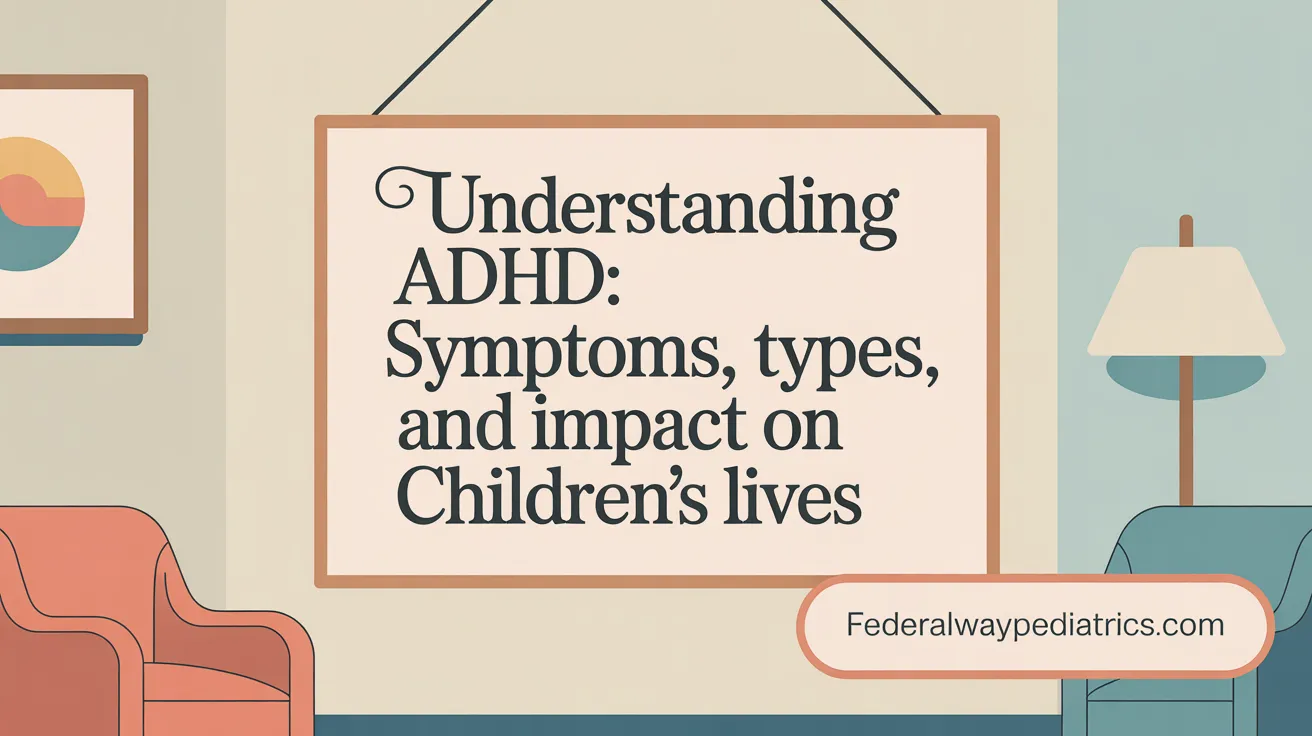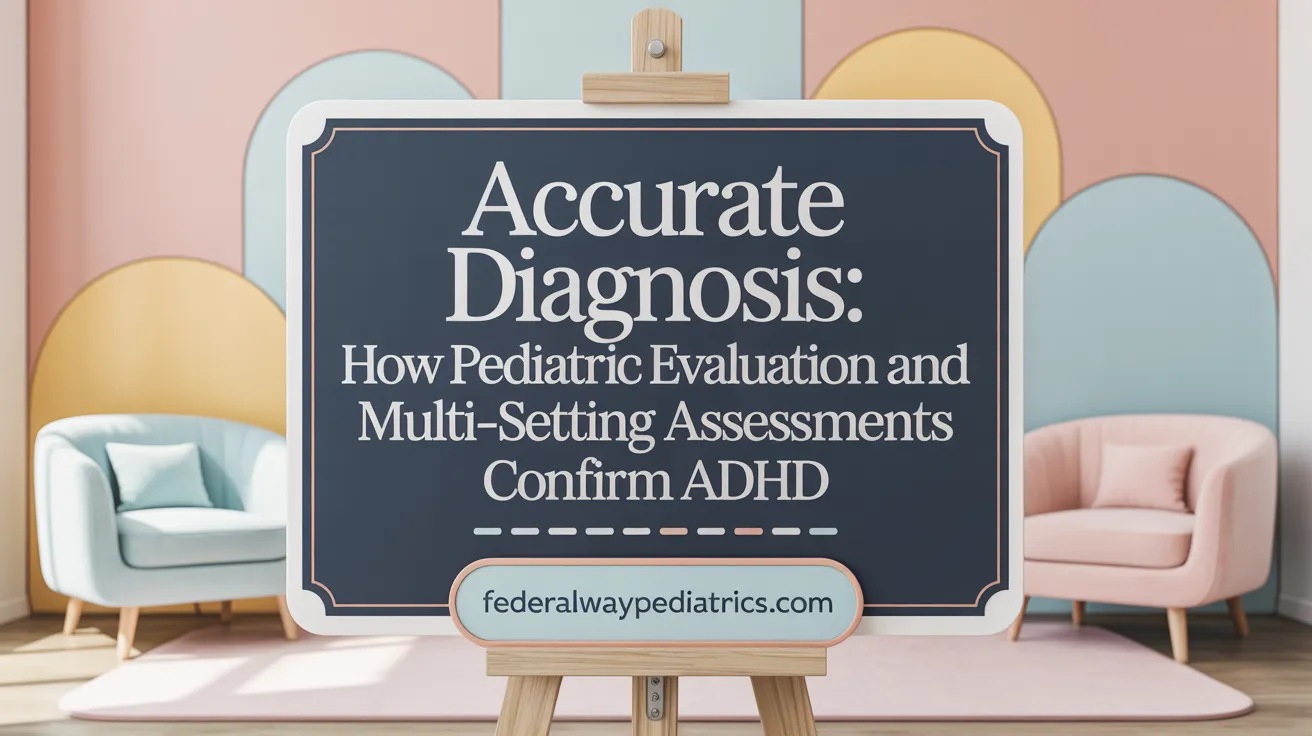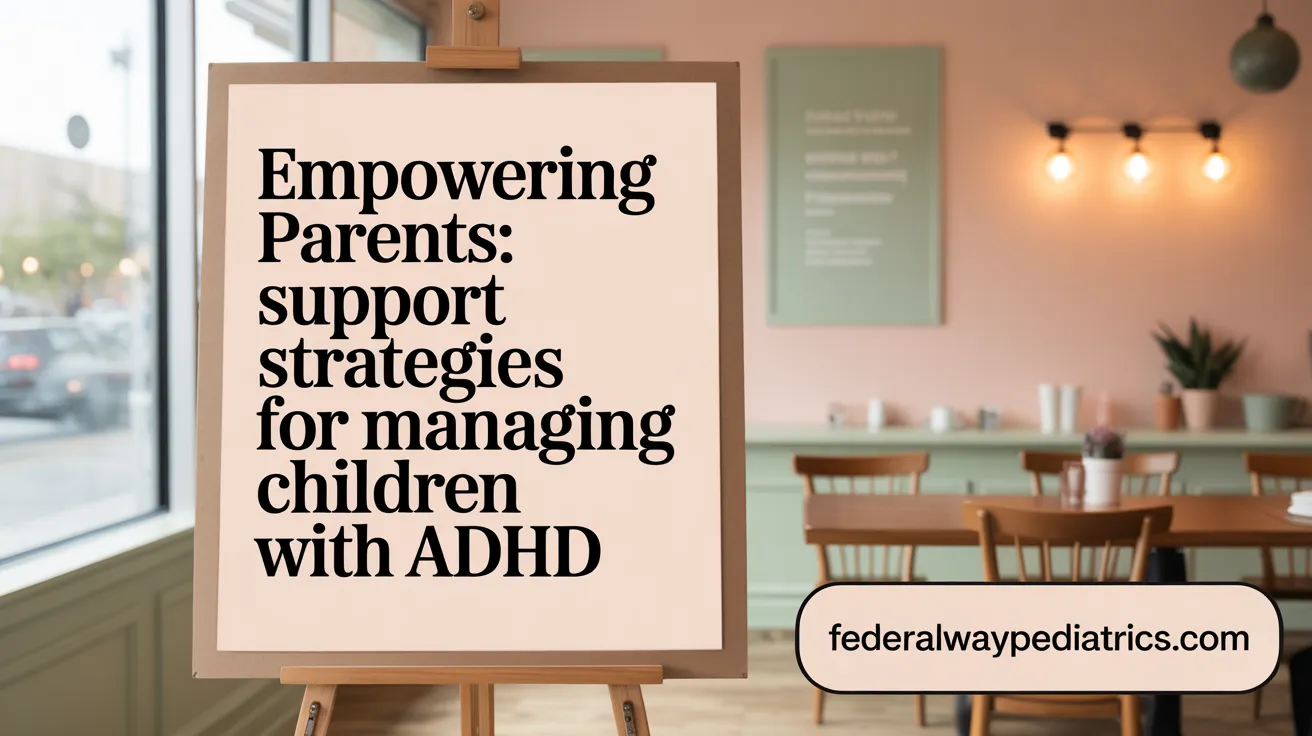Introduction to Pediatric Health and ADHD
Overview of pediatric health challenges
Children face a variety of health challenges as they grow, ranging from common illnesses like colds and ear infections to more complex developmental and behavioral conditions. Ensuring comprehensive pediatric care supports their physical, emotional, and social development, helping them thrive at home, school, and beyond.
Introduction to ADHD as a common pediatric disorder
Attention-Deficit/Hyperactivity Disorder (ADHD) is one of the most frequently diagnosed behavioral disorders in children. It is characterized by symptoms such as inattention, hyperactivity, and impulsivity, which can impact academic performance, social relationships, and self-esteem. ADHD affects millions of children and can persist into adulthood, requiring ongoing support and management.
Importance of early diagnosis and management
Early identification and management of ADHD are critical to improving outcomes for children. Diagnosis typically involves gathering detailed information from families and schools to assess symptom duration and impact across settings. Effective treatments, including medication and behavioral therapies, combined with educational supports, enable children to develop coping strategies and reach their full potential. Early intervention also helps prevent complications like anxiety and social difficulties, ensuring children receive the care they need promptly.
What is ADHD and How Does it Affect Children?

Definition and Symptoms of ADHD
Attention-Deficit/Hyperactivity Disorder (ADHD) is a neurodevelopmental disorder that primarily involves symptoms of inattention, hyperactivity, and impulsivity. Children with ADHD may struggle to maintain focus, exhibit excessive movement or talking, and act without thinking, which can lead to challenges in daily activities.
Types of ADHD
ADHD is classified into three main types: predominantly inattentive, predominantly hyperactive/impulsive, and combined presentation—the latter being the most common. The inattentive type involves difficulty sustaining attention and organizing tasks, while the hyperactive/impulsive type is marked by excessive activity and impulsive behavior. Many children experience a mixture of these symptoms. For more details on ADHD subtypes in children and ADHD symptom requirements by age, see relevant resources.
Age-Related Symptom Variations
Symptoms often appear before the age of 12 and can manifest differently as children grow. Hyperactivity tends to decrease with age, while inattentive symptoms may persist. Adolescents and adults might experience less overt hyperactivity but continue to face challenges with attention and impulse control. See ADHD symptom requirements by age for more information.
Prevalence and Gender Differences
ADHD affects millions of children, with diagnosis rates higher in boys during childhood. Boys are often diagnosed with the hyperactive/impulsive or combined types, whereas girls more frequently exhibit the inattentive form and may be underdiagnosed as a result. Symptoms can persist into adulthood for over half of those affected. More on ADHD prevalence by sex and Gender differences in ADHD diagnosis is available.
Impact on Daily Life and Development
ADHD can interfere with academic achievement, social relationships, and self-esteem. Children may face increased school anxiety, difficulties forming friendships, and behavioral issues. Early recognition and management are important to support children's development and well-being. For guidance on managing ADHD in children and parent support for ADHD, explore these resources.
Diagnostic Criteria and Evaluation for ADHD in Pediatrics

How is ADHD diagnosed in children?
Diagnosing ADHD in children involves a comprehensive clinical approach guided by the DSM-5 ADHD Diagnostic Criteria. For children under 16 years old, diagnosis requires the presence of at least six symptoms of inattention and/or hyperactivity-impulsivity persisting for a minimum of six months. Older adolescents and adults require five or more symptoms. Importantly, these symptoms must cause functional impairment in at least two settings, typically home and school, confirming that difficulties are pervasive and not situational. Detailed information on ADHD diagnosis in children can also be helpful.
Role of clinical history and assessment tools
Healthcare providers conduct thorough clinical histories, physical examinations, and employ validated assessment tools like ADHD rating scales. These tools gather observations from caregivers, teachers, and the child, providing a multi-source perspective. Tracking symptom duration and consistency ensures accurate diagnosis, as outlined in ADHD evaluation and assessment.
Differential diagnosis and coexisting conditions
Evaluation must also exclude or identify other conditions that could mimic ADHD symptoms or coexist, such as anxiety disorders, mood disorders, learning disabilities, sleep disturbances, and neurological issues. Comprehensive assessment helps tailor treatment and avoid misdiagnosis, further discussed in ADHD and comorbid conditions.
Importance of multi-setting evaluation
Noticing that symptoms affect various environments is crucial for diagnosis. Observations from multiple settings, including home, school, and social environments, ensure that behavioral patterns are consistent and persistent rather than temporary or context-specific. For guidance on parent and teacher collaboration in ADHD assessment, refer to specialized ADHD resources.
This structured evaluation process supports early and accurate ADHD diagnosis critical for effective management and positive outcomes in affected children, as emphasized in comprehensive guides on ADHD diagnosis and treatment.
Genetic and Environmental Factors Contributing to ADHD

What causes ADHD in children?
ADHD primarily arises from a combination of genetic and environmental factors. The disorder shows a strong hereditary pattern, with studies estimating its heritability at about 74%. This means that children with a family history of ADHD are significantly more likely to develop the condition themselves. Genetics influence brain structure and function, particularly areas responsible for attention regulation and impulse control.
Environmental influences also play a crucial role. Prenatal exposures, especially to tobacco smoke during pregnancy, increase the risk of ADHD. Additionally, infants born prematurely or with low birth weight are more vulnerable to developing symptoms of ADHD. Exposure to environmental toxins such as lead can further impact neurological development and contribute to ADHD symptoms.
Together, these genetic and environmental factors affect the developing brain's neurotransmitter systems, which regulate behavior and attention. While genetics are the dominant contributors, the severity and specific presentation of ADHD often result from the interplay between inherited traits and external exposures throughout prenatal and early childhood periods.
Treatment Modalities for ADHD: Behavioral and Pharmacologic Approaches

What are the common treatment options for ADHD?
Treatment for ADHD generally combines behavioral therapies for ADHD with medication treatment for ADHD to optimize outcomes.
Behavioral therapies and parent training
Behavioral interventions focus on improving organizational skills, social interactions, and coping strategies. Parent training for ADHD is essential, helping caregivers establish clear expectations, consistent discipline, and positive reinforcement. Classroom management techniques and social skills development also support children's success. For preschool-aged children (under six years), behavioral therapy is the primary recommended treatment.
Medication options: stimulants and non-stimulants
For children six years and older, stimulant medications for ADHD are the first-line treatment. Common stimulants include methylphenidate and dextroamphetamine, which increase brain chemicals involved in attention and impulse control. When stimulants are unsuitable, non-stimulant alternatives such as atomoxetine, viloxazine, and alpha-2 receptor agonists (e.g., guanfacine ER, clonidine ER) are available.
Emerging medication formulations
New stimulant formulations offer flexible dosing and longer duration of action. Examples include prodrugs like Azstarys and delayed-release options like Jornay PM, providing extended symptom control throughout the day and into the evening. For more details, see ADHD treatments overview.
Benefits and potential side effects of treatments
Medications effectively reduce core ADHD symptoms such as inattention and hyperactivity but require monitoring for side effects, including appetite suppression, sleep disturbances, and minor cardiovascular changes (e.g., increased heart rate or blood pressure). Behavioral therapies complement medication by addressing social skills and functional impairments without side effects.
Combining behavioral and medication therapy
Integrating behavioral interventions for ADHD with pharmacologic treatments yields the most comprehensive benefits. This combined approach helps manage symptoms, improves academic and social functioning, and supports family involvement in care.
This multifaceted treatment plan is supported by pediatric specialists, including those available in Federal Way, Washington ADHD pediatric care, providing accessible and evidence-based care for children with ADHD.
Supporting Families and Parents in Managing ADHD

How can parents support children with ADHD?
Parents have a vital role in effectively managing ADHD and fostering their child's well-being. Education and behavioral training for parents are foundational, helping them set clear expectations, apply consistent discipline, and reinforce positive behaviors.
Active involvement in educational planning is essential. Understanding legal protections like IDEA and Section 504 Plans educational accommodations enables parents to advocate for accommodations that support their child's learning needs. See Parenting a Child with ADHD for more info.
Utilizing resources such as CHADD and local support groups offers parents valuable information, emotional support, and practical strategies from others facing similar challenges.
Effective communication and positive reinforcement strengthen the parent-child relationship. Spending special one-on-one time, celebrating achievements, and fostering social skills help build self-esteem and resilience. Learn more about Parent support for ADHD.
Managing parental stress and maintaining healthy family dynamics are also critical. Support networks and professional guidance can help parents cope with the complexities of ADHD management, benefiting the entire family environment.
School-Based Interventions and Educational Accommodations
What educational supports exist for children with ADHD?
Children with ADHD often require tailored educational supports to address their unique learning challenges and behavioral needs. Individualized Education Programs (IEPs) serve as personalized plans developed collaboratively between educators, parents, and healthcare providers to define specific goals and accommodations. These plans may include modified assignments, behavior intervention strategies, and assistive technologies. IEPs and 504 Plans for ADHD
Section 504 Plans provide accessibility measures ensuring children with ADHD receive equal access to education through accommodations such as extended time for tests, preferential seating to reduce distractions, and modified homework expectations. Section 504 Plans educational accommodations
Collaboration among healthcare providers, educators, and families is vital to monitor progress and adapt strategies. School-based behavioral interventions and classroom management techniques—like clear instruction, structured routines, and positive reinforcement—are effective at supporting attention and reducing disruptive behaviors. Behavioral therapy for ADHD
Early educational intervention leads to measurable improvements in academic outcomes and psychosocial well-being, minimizing school anxiety and fostering better peer relationships. Early diagnosis and intervention for ADHD
By integrating medical, educational, and behavioral support, children with ADHD receive comprehensive assistance critical to their success in the school environment. Parent support for ADHD
Lifestyle and Complementary Strategies in ADHD Symptom Management
Can lifestyle changes help manage ADHD symptoms?
Lifestyle modifications play an important supportive role in managing ADHD symptoms alongside medical and behavioral treatments. Regular exercise has been shown to improve attention and reduce hyperactivity in children with ADHD. Physical activity stimulates brain areas involved in focus and impulse control, which can enhance day-to-day functioning.
A healthy, balanced diet and sufficient sleep are also crucial for emotional and cognitive regulation. Children benefit from meal plans rich in nutrients that support brain health and from routines that ensure consistent, restorative sleep.
Structured routines and organization at home can provide significant benefits. Clear, predictable daily schedules help children with ADHD manage their tasks more effectively and reduce distractions, supporting better behavior and learning outcomes. For more tips on managing ADHD in children, see tips for managing ADHD in children.
What about complementary therapies?
Although some complementary approaches, such as cognitive training and neurofeedback, have demonstrated potential in improving certain ADHD-related skills, more research is needed before they can be recommended as standalone treatments. Additionally, other alternative therapies like dietary supplements or herbal remedies currently lack solid scientific backing. For a deeper understanding of these therapies, see Complementary approaches to ADHD.
Families considering complementary methods should always discuss these options with their child’s healthcare provider to ensure safety and effective integration with prescribed treatments. Resources for professional ADHD help can be found at Professional ADHD help in Federal Way WA.
Supporting overall mental and physical health
Home-based behavioral strategies, including positive reinforcement, setting clear expectations, and rewards for good behavior, help children develop essential coping and social skills. These strategies not only improve ADHD symptoms but also enhance self-esteem and social relationships. For more on parent training and management, visit Parenting a Child with ADHD.
Focusing on comprehensive wellness—through exercise, nutrition, sleep hygiene, structured environments, and behavioral support—provides a foundation for children with ADHD to thrive in daily life. For additional behavioral strategies and treatment options, see ADHD treatments overview.
Navigating ADHD Care in Federal Way, Washington
What local resources and healthcare services are available for managing ADHD in Federal Way?
Families in Federal Way, Washington, are supported by several specialized pediatric healthcare services designed to effectively manage ADHD. [Mary Bridge Children’s Outpatient Center](https://www.marybridge.org/locations/mary-bridge-childrens-outpatient-center-federal-way/) is a central resource, providing comprehensive developmental behavioral pediatric care with access to therapy services like occupational, physical, and speech therapy. This multidisciplinary approach ensures children receive targeted support for ADHD symptoms.
The center also embraces modern technology through virtual urgent care visits, allowing families to consult healthcare providers remotely, an essential convenience for managing ongoing or urgent concerns.
Coordination with [Seattle Children’s South Sound Cardiology clinics](https://www.seattlechildrens.org/clinics/heart/south-sound-cardiology/) and [Heart Center](https://www.seattlechildrens.org/clinics/heart/) ensures that children with coexisting cardiac concerns receive expert evaluation and care, which is valuable since stimulant medications for ADHD require cardiac monitoring in some cases.
Parents benefit from integrated management tools such as MyChart, which makes scheduling appointments, accessing test results, communicating with providers, and managing prescriptions straightforward. This facilitates continuous, coordinated care for children diagnosed with ADHD.
Together, these local resources provide families with timely access to specialized evaluations, tailored treatment plans, and behavioral therapies, all geared toward optimizing outcomes for children with ADHD in Federal Way area.
Long-Term Considerations and Outcomes for Children with ADHD
What are the long-term outcomes for children with ADHD?
ADHD symptoms often persist beyond childhood. In fact, over half of children with ADHD continue to experience symptoms as adults. Many adults only recognize their condition after their own child is diagnosed. Untreated ADHD can lead to serious challenges including academic failure, school dropout, difficulties forming and maintaining relationships, increased risk of accidents, substance misuse, and legal problems.
Risks of untreated ADHD and the importance of monitoring
When left untreated, ADHD's impact extends into many aspects of life. Academic struggles and low self-esteem may cause long-term educational and occupational difficulties. Social challenges can contribute to isolation or problematic interactions. Therefore, children diagnosed with ADHD require ongoing care, including regular monitoring of symptoms and treatment side effects. This also involves adapting treatment plans as children grow and their needs change. For more details on ADHD diagnosis and treatment, please refer to professional guidelines.
Addressing coexisting conditions and promoting positive skills
Children with ADHD often have coexisting conditions like anxiety, mood disorders, learning disabilities, and sleep problems. Comprehensive evaluation and care strategies are essential to address these overlapping issues.
Therapeutic interventions focus not only on symptom management but also on developing organizational skills, social competence, and coping strategies. For support in parenting and Section 504 Plans educational accommodations, see Parenting a Child with ADHD and School supports like IEPs. Parenting support and school accommodations further promote positive self-esteem and academic success.
By fostering life skills, strengthening social relationships, and supporting emotional well-being, families and care teams can help children with ADHD achieve better long-term outcomes and improved quality of life. For additional tips for managing ADHD in children, please visit the provided resource.
Summary and Call to Action for Understanding and Managing Pediatric ADHD
Understanding the Impact of ADHD
ADHD affects a significant number of children and often continues into adulthood, influencing many aspects of a child's life including academic performance, social relationships, and self-esteem. This neurodevelopmental disorder, which includes symptoms of inattention, hyperactivity, and impulsivity, can pose challenges not only for children but for families as well.
Importance of Early Diagnosis and Comprehensive Treatment
Timely diagnosis is crucial. Symptoms must be present for at least six months and impact daily functioning in multiple settings such as home and school. Early intervention with a combination of behavioral therapies and medication can significantly improve outcomes. Treatments might include stimulant medications alongside parent training and school accommodations like IEPs and 504 Plans.
Leveraging Community and Healthcare Resources
Families in Federal Way and surrounding areas have access to specialized pediatric services such as those offered at Mary Bridge Children’s Outpatient Center and Seattle Children’s Heart Center. Utilizing local health professionals and support organizations plays an essential role in effective ADHD management.
Empowering Parents Through Involvement and Support
Parental engagement in educational planning and behavior management strategies is vital. Parents are encouraged to collaborate with healthcare providers, educators, and support groups to create tailored care plans, foster positive behavior, and advocate for their child’s needs.
By embracing a multidisciplinary approach, involving medical care, behavioral support, educational resources, and family participation, children with ADHD can thrive and reach their full potential.
